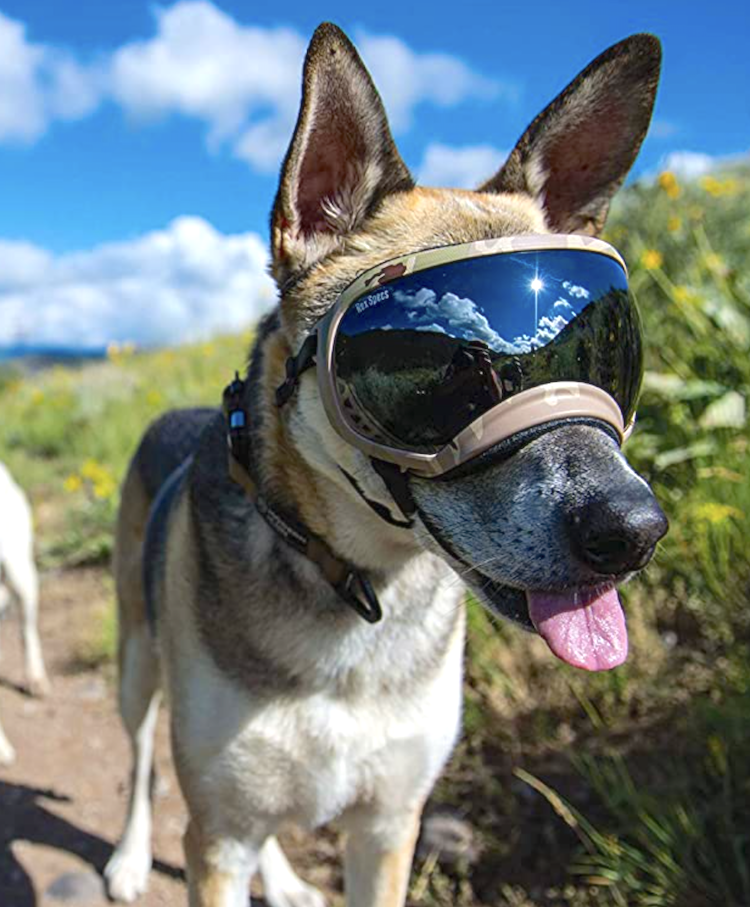Doggy Sunglasses: Does Your Pup Need Eye Protection?
There are specific circumstances where dogs may indeed benefit from wearing doggy sunglasses or goggles. Here’s what you need to know.

The ultimate in doggy dress-up, doggy sunglasses have a practical purpose and look super cute.
But is this the case: Should we see more dogs strutting their stuff in eye shades for the sake of their eyesight, or is it just a fashion statement? To paraphrase Jurassic Park, just because we can doesn’t mean we should.
Let’s take a ‘look’ at the pros and cons of doggy sunglasses.

Don’t leave your pet’s safety to chance
Sign up for Petful recall alerts today.

Why People Need Sunglasses: To Prevent Cataracts
Do our pets need eye protection in the same way people do? To answer this question, we need to consider why people wear sunglasses.
Among the top reasons people need sunglasses: Repeated exposure to ultraviolet (UV) rays causes cumulative damage to the eye’s lens, leading to cataract formation.
Cataracts form when the lens stops being transparent, like a freshly cleaned window, and instead becomes cloudy, like frosted glass. In the early stages this causes blurred vision, but eventually it leads to blindness because light is blocked from reaching the retina at the back of the eye.
In people, the early stages of cataract formation start in their 40s, with vision not being significantly affected until their 60s. That’s a lot of summers and repeated exposure to high UV levels.
What about dogs? For them, the sad truth is they don’t live long enough to build up 4 decades’ worth of UV damage. Thus, dogs don’t need to wear doggy sunglasses to prevent cataracts.
But, yes, some dogs do develop cataracts. Why is this?
Dogs get cataracts for different reasons. In canines, cataracts are most likely due to inherited genes or as a complication of diabetes mellitus.
Doggy Sunglasses May Help in Some Situations
Yes, dogs are different from people, but there are times when sunglasses might benefit them.
Eye Conditions
Canine cataracts due to UV damage may not be a thing, but UV light can cause problems for some dogs, including the following 3 conditions:
1. Pannus (Chronic Superficial Keratitis)
Think what it would be like wearing spectacles covered in duct tape. All the working parts of the glasses are there, but you can’t see through the lens because thick, dense, sticky tape is blocking the light.
This is the essence of what happens to dogs suffering from pannus. Their eyes work, but the cornea (the see-through surface of the eye) is covered in pigment, which prevents light from passing through into the eye itself.
In dogs it seems this problem is hereditary. The poster dogs for the condition are German Shepherd Dogs and mixes.
The pigment that forms is the result of an autoimmune reaction, where the body attacks its own tissue. The body’s immune system attacks the clear cornea, causing inflammation, which stimulates pigment to be laid down in an inappropriate place.
Ultraviolet light may play a part in switching on the immune reaction. Therefore, for German Shepherds — especially those working outdoors during the summer months — there is a strong argument for the use of doggy sunglasses. The sunglasses could shield the cornea from UV light and reduce the chance of pannus developing.
2. Uveodermatologic Syndrome
Another condition that can affect a dog’s eyes is uveodermatologic syndrome, sometimes referred to as VKH-like syndrome. This is different from pannus in that it can cause inflammation but within the eye.
Like pannus, this is thought to be an auto-immune condition, but with some differences.
Those most likely to suffer from this are Akitas and husky breeds, with the most obvious symptom being loss of pigment in the skin and coat, and discomfort in strong sunlight.
Why do their eyes hurt? Because of inflammation of the iris — which means it’s painful when the iris contracts in bright light.
Think of it as having a badly sprained ankle yet being forced to go on a 5-mile hike. It hurts! What you need is to rest the ankle. Shading the eyes with doggy sunglasses reduces the painful spasm in the iris and helps keep the dog comfortable.
3. Uveitis
is an umbrella term that describes inflammation within the eye, which may be the result of:
- A knock or blow to the eye
- An infection, such as Lyme disease
- High blood pressure
- Metabolic disease that causes toxins to buildup in the eye
- Cancer
Just as with uveodermatologic syndrome, bright light doesn’t cause the damage, but it’s painful when the eye works hard to adapt to bright light.
Long story short, if your dog shows signs of being uncomfortable in bright light, get them checked out by a veterinarian. Your pet may have a health condition requiring treatment to protect their eyesight.
Yes, doggy sunglasses may help keep the dog comfortable, but they are only part of the bigger picture.
Eye Trauma in Dogs
Doggy sunglasses can shield the eyes, a bit like safety glasses, and protect them from eye damage. In fact, dogs at risk of eye trauma constitute an even bigger group than dogs with eye-related medical problems.
So what types of dogs should consider protective eyewear? Here are 4 groups that come to mind:
1. Blind Dogs
An active blind dog may blunder into twigs and thorns, which could damage their eyes.
2. Search & Rescue or Working Dogs
A dog hot on a scent trail won’t be focusing on what’s before their eyes.
3. Riding Shotgun
Any dog who rides in a car with the windows down or travels in an open flatbed is at risk of having grit fly into their eye, causing damage.
4. Brachycephalic Breeds
have large, exposed eyes. These dogs are an increased risk of corneal ulcers, and there is an argument that protective eyewear just might reduce the chance of damage occurring.
These breeds include:

Doggy Sunglasses: Safety First
OK, so you’ve decided doggy sunglasses are the thing for your German Shepherd Dog who participates in competitive obedience trials outdoors in mid-summer.
Fine — but for the dog’s comfort and safety, please consider the following factors.
Perfect Fit
Find the right size sunglasses for your dog’s face.
Sunglasses for dogs come in all shapes and sizes and are designed to fit the full range of dog breeds — from 3 pounds to 200 pounds. Make sure you either take your dog’s measurements before buying the sunglasses or (even better) take your dog to a store to try them on.
To ensure the eyewear stays snugly on your dog’s face, no matter how much they wag or wiggle, buy either sunglasses that have an eyewear retainer or a pair of sunglass goggles.
Take Time Training
It’s imperative that the dog feels comfortable in their new shades and isn’t distressed by them. Be patient and take plenty of time, using reward-based methods, to get the dog used to wearing the sunglasses.
One manufacturer of eyewear for dogs, Doggles, recommends waiting until you are outside to put on the sunglasses.
“Don’t let your dog paw at the glasses or roll to get them off,” advises Doggles. “Reassure your dog that it’s OK. Then, immediately take them to bright sunlight and let them realize that they can see with them on.”
It will take time and training to acclimate your dog to their new accessory, especially if your pup is older.
Take things slowly: Have them try on their new shades for a few moments at a time, then take them off and offer a fun treat or toy as a reward. Continue this training regularly, increasing the amount of time you leave on the sunglasses.
Caution: Goggles Can Cause Suction on the Eyes
Breeds with exceptionally large eyes, such as Pugs or Pekes, are at greater risk of eyeball prolapse. This serious condition occurs when the eyeball pops out of the socket.
Things that can cause prolapse include scruffing a dog so the skin is pulled away from the eye, as well as anything that causes suction on the eyeball.
For doggy sunglasses of the goggles type, if they are too tight, this can cause a degree of suction within the eyepiece. Then, if the glasses are removed too quickly or in a clumsy way, there is a slight risk of literally sucking the eye out of the socket — which no one wants.
Moral of the story: Make sure your dog’s sunglasses aren’t too tight. Always gently break the “air seal” before you remove the glasses, by allowing some air in at the side before attempting removal.
Here’s a quick video of dogs wearing goggles on outdoor adventures:

Learn more:Rex Specs dog goggles on Amazon
.
Final Thoughts on Doggy Sunglasses: Fashion or Function?
There’s no one answer as to whether or not dogs really need sunglasses.
- At one end of the spectrum would be a German Shepherd Dog who spends lots of time in bright sunlight (yes to doggy sunglasses).
- At the other extreme is a lapdog who only potters outside to toilet (no sunglasses).
One thing is clear, though: If your dog shows signs of having uncomfortable eyes, such as squinting, avoiding bright light or holding one eye shut, always visit the vet.
Your pet may well have a medical problem that needs treatment — and while doggy sunglasses look super cool, they won’t solve the problem.
References
- Gray, Dan. “Put on Those Shades… Sunglasses Can Help Prevent Eye Disease.” Healthline. July 31, 2018. https://www.healthline.com/health-news/sunglasses-help-prevent-eye-disease#1.
- “Sunglasses: Your Prescription for Eye Health.” American Academy of Ophthalmology. July 13, 2018. https://www.aao.org/newsroom/news-releases/detail/sunglasses-your-prescription-eye-health.
- “5 Reasons Why It’s Important to Wear Sunglasses.” Val Vista Vision. June 2016. https://valvistavision.com/2016/06/5-reasons-important-wear-sunglasses/.
- “At a Glance: Cataracts.” National Eye Institute. https://www.nei.nih.gov/learn-about-eye-health/eye-conditions-and-diseases/cataracts.
- “Vogt-Koyanagi-Harada-Like Syndrome in Dogs.” Mar Vista Animal Medical Center. Oct. 26, 2018. https://www.marvistavet.com/vkh-syndrome.pml.
- Grant, David. “Canine Uveodermatologic Syndrome (Vogt-Koyanagi-Harada-Like Syndrome).” Veterinary Practice. Aug. 1, 2015. https://veterinary-practice.com/article/canine-uveodermatologic-syndrome-vogt-koyanagi-harada-like-syndrome.
- Zarfoss, Mitzi K., DVM, et al. “Clinical Findings and Outcomes for Dogs With Uveodermatologic Syndrome.” Journal of the American Veterinary Medical Association 252, no. 10 (May 15, 2018): 1263–1271. https://avmajournals.avma.org/doi/10.2460/javma.252.10.1263.
- Llera, Ryan, DVM, and Ernest Ward, DVM. “Uveitis in Dogs.” VCA Hospitals. 2019. https://vcahospitals.com/know-your-pet/uveitis-in-dogs.
- “Tips, Tricks & Instructions.” Doggles. 2019. https://woof.doggles.com/tips-tricks.







